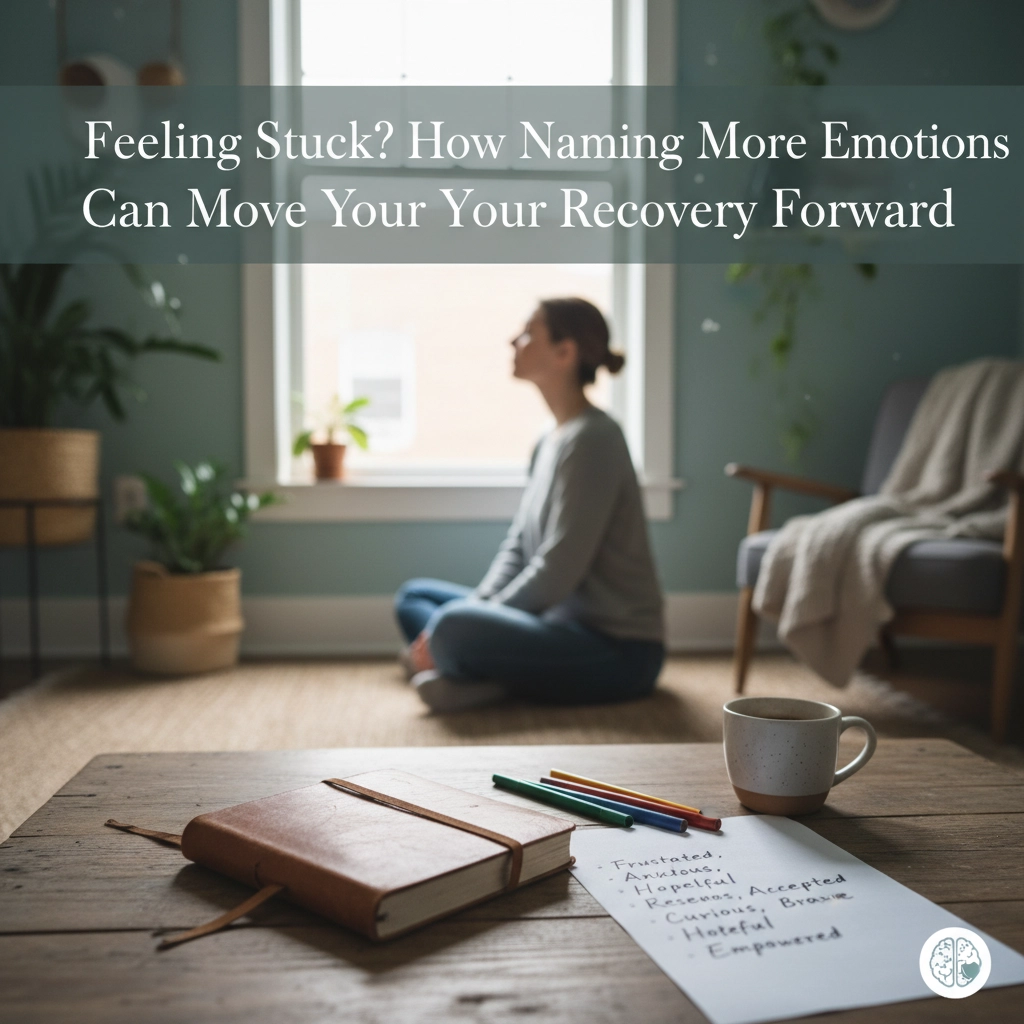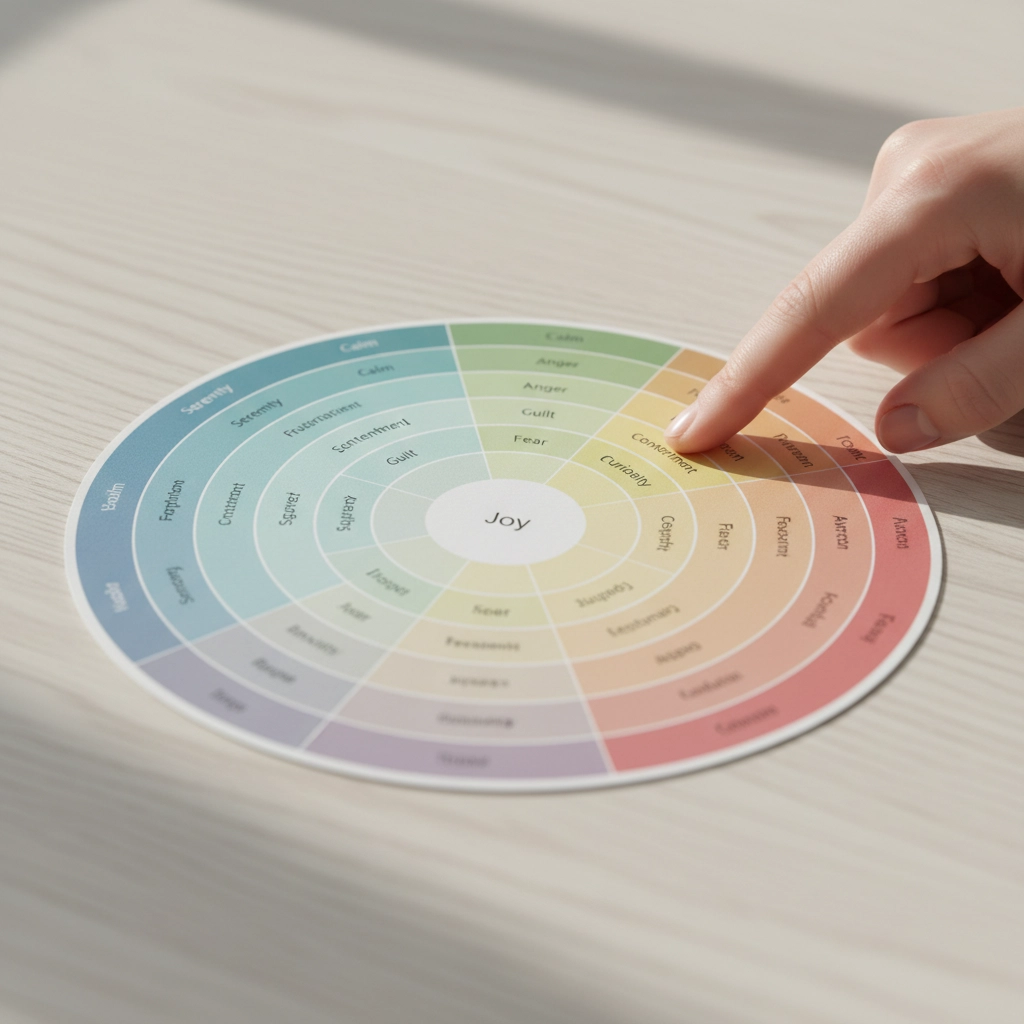by Andrew John Tucker, LCSW, CASAC

Picture this: you’re sitting in your apartment, staring at your phone after another argument with your partner, and someone asks you how you’re feeling. “Bad,” you say. Or maybe “upset.” If you’re really digging deep, perhaps “angry.” But here’s the thing: when we limit ourselves to these basic emotional labels, we’re essentially trying to navigate the complexity of recovery and relationships with the emotional vocabulary of a third-grader.
And that’s not doing us any favors.
If you’re in recovery, you know that feelings can be overwhelming, confusing, and sometimes feel like they’re happening to you rather than with you. But what if I told you that simply expanding how you name and talk about your emotions could be one of the most powerful tools in moving your recovery forward?
When “Fine” Isn’t Fine Enough
Let’s be honest: most of us learned to navigate the world with a pretty limited emotional vocabulary. We’ve got our greatest hits: happy, sad, angry, scared, fine. Maybe we throw in “stressed” or “anxious” when we’re feeling fancy. But when you’re dealing with the complex web of emotions that come with addiction recovery, gambling recovery, or just being a human in New York City, those few words are like trying to paint the Mona Lisa with only primary colors.
The problem with emotional vagueness is that it keeps us stuck. When everything feels “bad” or “overwhelming,” we don’t have the clarity to understand what’s actually happening inside us, let alone figure out what to do about it.

Think of it this way: if you walked into an urgent care clinic and told the doctor you felt “bad,” they’d need a lot more information before they could help you, right? Your emotions deserve the same specificity and attention.
The Science Behind Naming What We Feel
Here’s where things get interesting (and this always fascinates me as a therapist): research shows that when you accurately name an emotion, something remarkable happens in your brain. The act of labeling feelings actually reduces activity in your amygdala: that’s the part of your brain that handles fear and emotional reactivity: while increasing activity in your prefrontal cortex, which is responsible for thinking, planning, and emotional regulation.
In plain English? Naming your emotions literally calms your brain down.
This isn’t just feel-good therapy speak: it’s neuroscience. When you can say “I’m feeling ashamed about my gambling last night” instead of “I feel like crap,” you’re giving your brain permission to shift from panic mode into problem-solving mode. And in recovery, that shift can be the difference between acting on an impulse and making a choice that aligns with your values.
Beyond “Good” and “Bad”: Expanding Your Emotional Range
So how do we move beyond our emotional greatest hits album and start exploring the deep cuts? It starts with curiosity rather than judgment. Instead of asking “Am I feeling good or bad?” try asking “What exactly am I feeling right now?”
Let’s get specific. Instead of “angry,” you might be:
- Frustrated (blocked from getting what you want)
- Irritated (annoyed by something small but persistent)
- Resentful (angry about something that feels unfair)
- Indignant (angry about a violation of your values)
- Furious (intense, overwhelming anger)
See the difference? Each of these emotions points toward different underlying needs and different potential responses. When you’re frustrated, you might need to problem-solve or find a different approach. When you’re resentful, you might need to address a boundary violation or have a difficult conversation.

For those of us in recovery, this specificity is particularly crucial. The urge to engage in addictive behaviors might be triggered by boredom, anxiety, excitement, loneliness, or shame: and each of these emotions calls for a different coping strategy. When we can name the specific feeling, we can choose a specific response rather than falling back on old patterns.
Practical Tools for Emotional Expansion
The Feelings Check-In
Start small. Three times a day: maybe when you wake up, in the afternoon, and before bed: pause and ask yourself: “What am I feeling right now?” But here’s the key: don’t settle for the first word that comes to mind. Push yourself to get more specific.
Want to get really fancy? Ask Chat GPT to teach you two new “feeling words” every morning with clear examples of how to use them with nuances that make the particular words distinct.
Then try this: “I’m feeling… and underneath that, I’m also feeling… and there’s also some…”
Most emotions aren’t solo acts: they travel in packs. You might be anxious and excited about a job interview, or sad and relieved about ending a relationship.
The Body Scan Method
Your body often knows what you’re feeling before your mind catches up. Notice where you feel tension, heaviness, or energy in your body, then ask what emotion might live there. That knot in your stomach might be anxiety. The heaviness in your chest could be grief. The tension in your shoulders might be carrying some anger or stress.
This is particularly helpful for those of us who have learned to disconnect from our feelings as a survival strategy. Addiction often teaches us to numb or avoid emotions, so reconnecting with the physical experience of feelings can be a gentle way back in.
The Emotion Wheel
Visual learners, this one’s for you. Emotion wheels (you can find them online or I can provide one if you’d like) start with basic emotions in the center and branch out into more specific variations. It’s like having a thesaurus for your feelings.

Start in the center with a basic emotion, then follow the branches outward until you find something that fits more precisely. Instead of “sad,” you might discover you’re actually feeling “disappointed” or “melancholic” or “heartbroken”: each pointing toward different experiences and needs. I’ve always felt the dimly lit, classically poetic beauty of emotions are reserved for this special place, creating a unique memorable experience.
How Emotional Precision Moves Recovery Forward
When you can name your emotions with precision, several important things happen:
First, you gain agency. Instead of being overwhelmed by mysterious “bad feelings,” you have specific information you can work with. You can’t solve what you can’t name.
Second, you improve your communication. When you tell your therapist, sponsor, partner or friend that you’re “feeling triggered to gamble because you’re feeling understimulated and craving excitement,” that gives them much more to work with than “I want to go to the casino because I feel bad.”
Third, you develop emotional tolerance. Paradoxically, when you can name difficult emotions precisely, they become more bearable. There’s something about acknowledgment that takes the edge off. It’s like the difference between being lost in a foreign city versus being lost but having a map: same situation, but one feels more manageable.
The Ripple Effect in Recovery
This precision creates a ripple effect throughout your recovery journey. When you understand what you’re feeling and why, you can:
- Choose more effective coping strategies (mindfulness for anxiety, movement for restlessness, connection for loneliness)
- Identify patterns and triggers more clearly
- Communicate your needs to your support system more effectively
- Make decisions from a place of awareness rather than reactivity
Making It Practical
Living in NYC adds its own emotional complexity to recovery. The constant stimulation, financial pressure, social opportunities, and accessibility to addictive behaviors create a unique emotional landscape. Being able to name whether you’re feeling overstimulated by the subway, lonely in a crowd, or financially anxious can help you navigate the city’s particular challenges to your recovery.
The goal isn’t to become an emotion expert overnight: it’s to gradually expand your emotional awareness and vocabulary. Start where you are, with what you’re feeling right now, and get curious about the nuances.

Remember, naming emotions isn’t about fixing or changing them immediately. It’s about giving them space, acknowledging their presence, and gathering information about your inner experience. Sometimes the simple act of accurate naming is enough to shift your relationship with the feeling entirely.
Your emotions aren’t obstacles to your recovery: they’re information, messengers, and often, the very path forward. When you can name them clearly, you give them the voice they deserve, and in return, they can guide you toward the healing and growth you’re seeking.
The next time someone asks how you’re doing, consider going beyond “fine.” Your emotional precision might just be the key that unlocks your next step in recovery. And if you’re looking for support in developing these skills, remember that therapy can provide a safe space to practice and refine this crucial aspect of your recovery journey.
